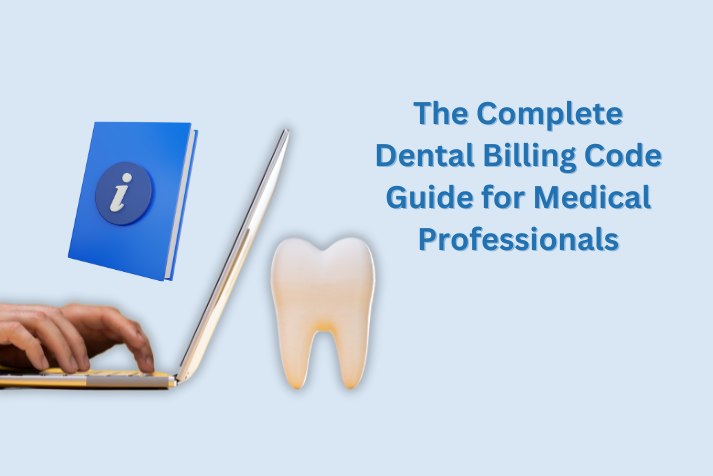The financial aspects of dental care can be effectively managed with the use of dental billing codes. To submit claims of insurance, they offer a standardized way of reporting and documenting dental services. By ensuring that the services are correctly documented and fairly rewarded, these regulations help dental clinics stay solvent financially and operationally stable.
Understanding of Dental Billing Codes
Dental billing codes are identifiers, either numeric or alphanumeric, that are used to consistently define dental treatments and services. They guarantee effective communication between insurance firms, billing experts, dentists, and other healthcare system participants. These codes are crucial to the healthcare revenue cycle because they enable dental offices to properly record services, expedite billing procedures, and get prompt insurance reimbursements.
The Importance of Dental Billing Codes in the Healthcare Revenue Cycle
The following reasons make dental billing codes crucial to the healthcare revenue cycle:
- Provide accurate billing: which prevents revenue losses from underbilling or denials from overbilling.
- Enhancing efficiency: streamlines the process of claim submission, reducing the administrative burden on dental offices.
- Enhancing compliance: makes use of globally approved, established codes to assist practices in complying to industry laws.
The Significance of American Dental Association (ADA) Billing Codes
The American Dental Association (ADA) billing codes, often known as Current Dental Terminology (CDT), are the industry standard for dental billing.
These codes are essential to keeping the billing process precise and consistent. ADA billing codes are widely accepted and revised frequently to take advantage of the most recent advancements in dental technology and practices.
- Standardization: They offer a common language for dental treatments offered by various locations and practitioners.
- Current practices: Frequent updates guarantee that newly implemented processes and technology are correctly programmed and charged.
- Audit-readiness: Making use of ADA-compliant codes reduces the possibility of audits and fines resulting from obsolete or erroneous coding.
Effective Use of Dental Billing Codes
Healthcare providers need to keep up with the most recent ADA code updates and quickly incorporate them into their billing systems to use dental billing codes efficiently. For billing personnel to maintain accuracy in their coding procedures, training and ongoing education on dental billing codes are essential.
Entire Collection of Crucial Dental Billing Codes
Healthcare personnel should be aware with the most common dental billing codes, especially if they are new to the sector or need to refresh their knowledge. These categories include everyday preventive care as well as complex restoration procedures. The codes are categorized in this area to make it easier for practitioners to locate and use the right ones quickly, improving the precision and effectiveness of their billing procedures.
Common Dental Billing Codes Categorized
| Category | Code | Description | Usage Notes |
| Diagnostic | D0120 | Periodic oral evaluation | Used for routine check-up visits |
| Preventive | D1110 | Prophylaxis – adult | Standard adult cleaning |
| Restorative | D2140 | Amalgam – one surface, primary or permanent | Filling for a single-surface cavity |
| Endodontics | D3310 | Root canal therapy – anterior | Root canal on a front tooth |
| Periodontics | D4341 | Periodontal scaling and root planing, per quadrant | Deep cleaning for gum disease |
| Prosthodontics (removable) | D5110 | Complete denture – upper | Used when an upper denture is needed |
| Oral Surgery | D7140 | Extraction, erupted tooth or exposed root | Standard tooth extraction |
| Orthodontics | D8080 | Comprehensive orthodontic treatment, adolescent | Braces for patients under 18 |
Amendments and Modifications to Dental Billing Codes
Keeping Updated about Dental Codes for Insurance Billing
Dental billing codes are routinely revised to reflect new procedures, technologies, and laws. To guarantee compliance and optimize payments, healthcare professionals, particularly those managing the financial side of dental practices, need to keep updated. It’s critical to use the most recent dental codes when billing insurers.
Resources to Keep Up with the Times
It might be difficult to stay up to speed with dental billing code changes, but several trustworthy resources can assist:
1. Professional Associations:
- American Dental Association (ADA): They update their American Dental Association billing codes regularly.
- Academy of Dental Management Consultants: The Academy of Dental Management Consultants provides courses and materials regarding the most recent billing procedures.
2. Journals and Newsletters for Industry:
- Obtain newsletters from reputable companies that provide dental billing consulting.
- Examine trade publications that concentrate on managing dental practices.
3. Webinars and online courses:
- Take dental billing-focused continuing education classes to further your education.
- Attend webinars covering upgrades and modifications to billing codes.
4. Establishing peer networks:
- Participate in forums and professional groups where colleagues exchange updates and thoughts.
- Attend dental healthcare management seminars and workshops.
Common Challenges and Solutions
Solving Common Problems with Dental Billing Codes
Dental businesses depend on dental billing codes to function, but handling them can be difficult in several ways. It is essential to understand these issues and put practical solutions in place if billing procedures are to run smoothly and prompt payments are to be guaranteed. Here, we review a few typical issues and provide troubleshooting guidance to help you deal with them effectively.
Common Challenges for Healthcare Professionals
Keeping Up with Change: Dental billing codes are constantly modified, which might result in the usage of out-of-date codes if not closely checked.
Human Error: Mistakes in entering codes can result in claim denials or payment delays.
Complexity of Services: Some dental procedures involve multiple steps that may need to be coded separately, which can confuse even experienced billers.
Insurance Plan Variability: Different insurance companies may interpret billing codes differently, resulting in errors in claim processing.
Practical Solutions and Troubleshooting Tips
To solve these difficulties, the following strategies may be highly effective:
| Challenge | Solution |
| Keeping Up with Changes | Sign up for updates from the American Dental Association (ADA) and other regulatory authorities. |
| Human Error | Implement double-checking protocols before the final submission of claims. |
| Complexity of Services | Use detailed charts and tools that break down complex procedures into their component billing codes. |
| Insurance Plan Variability | Maintain regular communication with insurance providers to clarify coding requirements and updates. |
Technology for Dental Billing Efficiency
An Overview of Software for Dental Billing
Dental practices rely significantly on dental billing software to ensure accurate and efficient billing procedures. These systems are designed to manage everything from patient scheduling and medical information management to insurance claim filing and monitoring.
Evaluating Popular Dental Billing Software
To assist you in selecting the best software for your office, here is a comparison of major dental billing software, outlining their advantages and disadvantages.
Comparison Table of Dental Billing Software
| Software | Pros | Cons |
| Dentrix | Comprehensive integration, user-friendly interface | High cost, steep learning curve for beginners |
| EagleSoft | Extensive reporting features, robust support | Limited customization options |
| Open Dental | Cost-effective, highly customizable | Requires technical knowledge to setup |
| Curve Dental | Cloud-based, accessible from any device | Monthly subscription fee, internet dependency |
Key Features to Consider
The following characteristics are especially helpful for handling dental billing codes, therefore keep them in mind when choosing dental billing software:
Code Accuracy: To reflect the most recent American Dental Association billing codes, the software should be updated regularly.
Claim Tracking: Claim Tracking refers to the process of tracking the status of individual claims from their submission to completion.
Integration: Integration is the seamless linking of one system to another, such as accounting software and electronic health records (EHR).
User assistance: Full-service customer assistance that includes user communities, helpdesks, and training.
Benefits of Using Dental Billing Software
Utilizing specialized dental billing software offers several advantages:
Efficiency: Automates routine tasks, reducing the time spent on manual entry.
Accuracy: Reduces errors in code entry and claims processing, possibly leading to speedier reimbursements.
Compliance: Ensures that billing procedures adhere to the most recent legislation and standards established by industry organizations such as the ADA.
Let’s Recap
Accepting the complicated nature of dental billing codes can help practice managers and patients alike, whether they are beginner medical billers or seasoned dental practice managers. Recall that the dental billing industry is constantly changing, so being knowledgeable and flexible is essential for success.
Do you need further advice or specialized assistance? Please Contact Us for our consultancy without delay. Our professionals are prepared to help you improve the financial stability of your dental business, guarantee compliance, and streamline your billing procedures.
FAQs
1. What are the dental billing codes?
Dental billing codes, often known as Current Dental Terminology (CDT), are standardized codes that define dental operations for billing and insurance purposes. These codes provide consistent recordkeeping, streamlined billing processes, and accurate insurance claims.
2. How frequently are dental billing codes updated?
Dental billing codes are frequently revised every year to reflect new technologies, procedures, and changes in dental practice. Healthcare practitioners must stay updated on these improvements to guarantee appropriate invoicing and compliance.
3. Why is it critical to use the appropriate dental billing codes?
Using the correct dental billing codes is critical for numerous reasons: it ensures that dental practices are correctly reimbursed for services rendered, lowers the likelihood of claim rejections and delays, and aids in the compliance with insurance regulations and standards.
4. What resources are available to help me learn about changes to dental billing codes?
Professionals can stay up to date on dental billing code changes by visiting the American Dental Association’s (ADA) website, reading industry bulletins, and taking professional courses. Subscribing to these updates keeps them informed of any new modifications.
5. How can dental practices ensure that their employees are properly trained in using dental billing codes?
Dental clinics can keep their employees well-trained by investing in continuing education and training programs in dental billing. This involves receiving software training and attending workshops and seminars for hands-on experience and up-to-date information on best practices.




